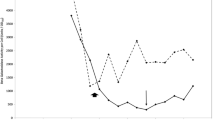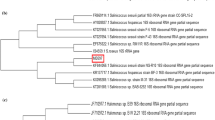Abstract
Serratia marcescens biovar A2/A6, isolated from an Indonesian freshwater source, was identified based on extensive morphological, biochemical and genetic characterization. Formation of pigment was found to be strongly influenced by environmental conditions. Placket-Burman design was used to analyze the effect of carbon and nitrogen sources. Based on results of physiological and biochemical studies, the optimum conditions for growth and pigment formation were incubation 30°C in a neutral to slightly alkaline medium containing lactic acid and beef extract.
Similar content being viewed by others
Abbreviations
- E i,j :
-
The effect of ith on jth-variable (i=1 to 8 & j=1 to 4)
- ni,j (+):
-
The number of experiments at high concentrations of ith-variable which is equal to 6
- ni,j (−):
-
The number of experiments at low concentrations of ith-variable which is equal to 6
- Ri,j (+):
-
Average final concentration of jth at high concentration of ith-variable
- Ri,j (−):
-
Average final concentration of jth at low concentration of ith-variable
- SE i,j :
-
Standard error of ith on jth-variable (i=1 to 8 & j=1 to 4)
- t :
-
t-value
- V i,j :
-
The variance of ith on jth-variable (i=1 to 8 & j=1 to 4)
References
Kalesperis, G. S., K. V. Prahlad, and D. L. Lynch (1975) Toxigenic studies with the antibiotic pigments fromSerratia marcescens.Can. J. Microbiol. 21: 213–220.
Gargallo, D., J. G. Loren, J. Guinea, and M. Vinas (1987) Glucose-6-phosphate dehydrogenase alloenzymes and their relationship to pigmentation inSerratia marcescens.Appl. Environ. Microbiol. 53: 1983–1986.
Gargallo-Viola, D. (1989) Enzyme polymosphism, prodigiosin production and plasmid fingerprints in clinical and naturally occurring isolates ofSerratia marcescens.J. Clin. Microbiol. 27: 860–868.
Tsuji, R. F., M. Yamamoto, A. Nakamura, T. Kataoka, J. Magae, K. Nagai, and M. Yamasaki (1990) Selective immunosuppression of prodigiosin 25-C and FK506 in the murine immune system.J. Antibiot. 153: 1293–1301.
Tsuji, R. F., J. Magae, M. Yamashita, K. Nagai, and M. Yamasaki (1992) Immunomodulating properties of prodigiosin 25-c, an antibiotic which preferentially suppress induction of cytotoxic T cells.J. Antibiot. 45: 1295–1302.
Kataoka, T., J. Magae, K. Kasamo, H. Yamanishi, A. Endo, M. Yamasaki, and K. Nagai (1992) Effects of prodigiosin 25-c on cultured cell lines: Its similarity to monovalent polyether ionophores and vacuolar type H+-ATP ase inhibitor.J. Antibiot. 45: 618–1625.
Songia, S., A. Mortellaro, S. Taverna, C. Fornasiero, E. A. Scheiber, E. Erba, F. Colotta, A. Mantovani, A. M. Isetta, and J. Golay (1997) Characterization of the new immunosuppressive drug undecylprodigiosin in human lymphocytes.J. Immunol. 3987–3995.
Itami, C., H. Matsunaga, T. Sawada, H. Sakurai, and Y. Kimura (1993) Superoxide dismutase mimetic activities of metal complexes of L-2 (2-pyridil)-1-pyroline-5 carboxylic acid (pyrimine).Biochem. Biophys. Res. Com. 197: 536–541.
Suzuki, K., H. Matsunaga, C. Itami, and Y. Kimura (1993) Polymyxin B enhances formation of a new pigment, a peptide-ferropyrimine complex inSerratia marcescens.Biosci. Biotechnol. Biochem. 57: 1763–1765.
Scott, R. H., S. M. H. Oadri, and R. P. Williams (1976) Role of L-proline in the biosynthesis of prodigiosin.Appl. Environ. Microbiol. 32: 561–566.
Vinas, M., A. El-Ebiary, J. Guinea, and J. G. Loren (1987) Effect of gramicidin A and Valinomycin on prodigiosin production by non-proliferatingSerratia marcescens.J. Antibiot. 150: 113–115.
Lynch, D. L., T. E. Worthy, and G. C. Kresheck (1968) Chromatographic separation of the pigment fractions from aSerratia marcescens strain.Appl. Microbiol. 16: 13–20.
Haaland, P. D. (1989),Experimental design in Biotechnology. Marcell Dekker, Inc. New York and Basel.
Chun, J. (1995)Computer Assisted Classification and Identification of Actinomycetes. PhD Thesis, University of New Castle upon Tyne, UK.
Trias, J., M. Vinas, J. Guinea, and G. Loren (1988) Induction of yellow pigmentation inSerratia marcescens.Appl. Environ. Microbiol. 54: 3138–3141.
Williams, R. P., C. L. Gott, S. M. Hussain Oadri, and R. H. Scott (1971) Influence of temperature of incubation and type of growth medium on pigmentation inSerratia marcescens.J. Bacteriol. 106: 438–443.
Feng, J. S., J. W. Webb, and J. C. Tsang (1982) Enhancement by sodium dodecyl sulfate of pigment formation inSerratia marcescens 08.Appl. Environ. Microbiol. 43: 850–853.
Rosenberg, M., Y. Blumberger, H. Judes, R. Barness, E. Rubinstein, and Y. Mazor (1986) Cell surface hydrophobicity of pigmented and nonpigmented clinicalSerratia marcescens stains.Infect. Immun. 51: 932–935.
Martin, J. F. and A. L. Demain (1980) Control of antibiotic biosynthesis.Microbiol. Rev. 44: 230–251.
Sole, M., A. Francia, N. Rius, and J. G. Loren (1997) The role of pH in the glucose effect on prodigiosin production by non-proliferating cells ofSerratia marcescens.Lett. Appl. Microbiol. 25: 81–84.
Bar, R. and J. S. Rokem (1990) Cyclodextrin-stimulated fermentation of prodigiosin bySerratia marcescens.Biotechnol. Lett. 12: 447–448.
Rokem, J. S. and P. Weitzman (1987) Prodigiosin formation bySerratia marcescens in a chemostat.Enzyme Microb. Technol. 9: 53–155.
Lin, T. F., K. Yakushijin, G. H. Buchi, and A. L. Demain (1992) Formation of water-soluble Monascus red pigments by biological and semy-synthetic process.J. Ind. Microbiol. 9: 73–179.
Author information
Authors and Affiliations
Corresponding author
Rights and permissions
About this article
Cite this article
Hardjito, L., Huq, A. & Colwell, R.R. The influence of environmental conditions on the production of pigment bySerratia marcescens . Biotechnol. Bioprocess Eng. 7, 100–104 (2002). https://doi.org/10.1007/BF02935887
Received:
Accepted:
Issue Date:
DOI: https://doi.org/10.1007/BF02935887




